- Sunday, June 01, 2025
- Stay Connected
 Abraham Lincoln
If given the truth, the people can be depended upon to meet any national crisis...
Abraham Lincoln
If given the truth, the people can be depended upon to meet any national crisis...
 Guildford news...
for Guildford people, brought to you by Guildford reporters - Guildford's own news service
Guildford news...
for Guildford people, brought to you by Guildford reporters - Guildford's own news service
Around The Very Top: Very Perceptible Gradients
Published on: 30 May, 2015
Updated on: 2 May, 2022
Martin Giles is cycling around the top of northern Scotland with his son Tom. This is a report on the third leg of their tour from Rhiconich to Durness. Find other reports in the series by searching on: “Around The Very Top”.
By Martin Giles
Getting wet on the 15 mile route from Rhiconich to Durness was almost a certainty but I had a cunning plan.
The BBC weather forecast indicated that it should be drier for our short ride north in the afternoon so I suggested to Tom that we set off later, perhaps even after lunch. He didn’t mind. Having recently completed his university exams he was free of any cares and seemed happy to leave the decision to me.
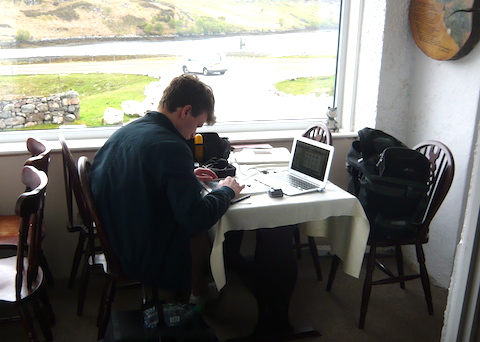
A later start meant that I had more time to write and Tom more time to read and catch upwith emails.
The other advantage of the plan was that we could use the time usefully: me to write, him to read.
The man with the Scottish/Irish accent (see “Not Too Proud To Push“) told us that we were in for some gradual climbs, “imperceptible” even. Even as he told us I wondered if he had ever actually cycled the route himself, or even walked it.
Somehow I doubted it. Us strangers might find the joys of walking and cycling in all weathers appealing but the locals, I suspect, have a more practical view of life.
Before any problem associated with gradient emerged, though, a problem of a mechanical kind literally stopped me in my tracks. I had set off without ensuring that my bungee was properly secured over my panniers.
Within the few yards that my brain registered something felt wrong it had wrapped itself around the back axle, the hook firmly wedged between the spokes.
I wondered whether I should wait for our support vehicle. It was an implicit agreement with the spanner monkeys at Pedal Pushers on Stoke Road who serviced my bike and who had supplied Tom’s that they provide bike breakdown cover whenever necessary. I am pretty sure that is what they said.
Last year on my ride to Edinburgh they had done so with the ultimate discretion. I had not spotted them once but I knew they must have been there a few miles behind. They wouldn’t let me down.
The open landscapes of this tour must have made it even more of a challenge for them. Perhaps they had a camouflaged van and, unlike the deer, knew not to break a skyline. It was uncanny just how invisible they were. It was almost as if they weren’t there at all.
Anyway, before they had to come to the rescue there were some power supply engineers parked up in the car park so I borrowed a screwdriver and some pliers and was soon able to extract what remained of the bungee.
I was anxious to get going. It was not raining and I hoped we could make it to Durness without getting caught in a shower.
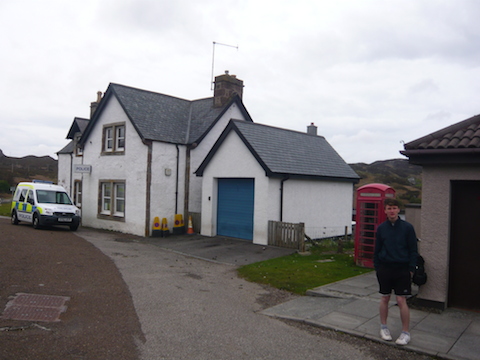
The police sytation at Rhiconich – perhaps not the ideal posting for an ambitious new copper. Meanwhile Tom gives a pigeon impression
We did stop though, to have a quick look at the police station. There did not seem to be a great deal of activity. I wondered what a young ambitious copper might think if this was his first posting.
Having said that, within a few yards we witnessed a flagrant breech of the highway code. Sheep were just wandering all over the road as if they had paid their road tax. (Yes, I know cyclists don’t pay either. Please don’t write in.)
We cycled on up the “imperceptible” hill. I was still finding that gravity was making them all too perceptible but I soon forgot all about that as we emerged, after only a short distance, back into a world of lochans, hillocks and wee burns, as my dear old mother-in-law would have described them. If you want to get away from everything this is the place.
We continued a gradual ascent. Not far from the road there were clear signs of peat cutting. Peat used to be the main heating fuel in the area before electricity was introduced in the 1950s, following the construction of the hydro dam in Lairg.
Prior to that, peat cutting was a major activity for crofting families who would spend one man month of effort cutting, drying and transporting sufficient peat each year.
Gradually the use of peat has declined but crofters still have the common grazing right to take peat, often, these days, a right they do not fully exercise. But some still were, it seemed, as these signs show. Generally peat extraction is deemed environmentally damaging and widespread use of peat for compost, for example, has been very much reduced.
We passed another very remote bed and breakfast and then, perhaps a mile later, we were at the summit. Tom took off straight away and disappeared around the bend while I paused to take a photo.
When I set off to follow, even around the bend where I could see for some distance there was no sign of Tom. I was quickly picking up speed. I glanced down at my speedo. 34 mph. Wow. For me, on a bike, that is very fast.
I could still not see Tom. There were no other roads so he could not have turned off. I had a slight worry that he had had a mishap and I had streaked past while he was unconscious in a ditch but I knew it was unlikely. Both of my sons love speed and I guessed that he had just gone on as far as possible as fast as possible.
Three miles further on I was proved right. Tom had parked up when further freewheeling was no longer possible. We both had enormous grins. The three mile descent had been terrific fun.
Tom gave me the last two squares of the chocolate bar bought in Lairg. It tasted good. A fine way to celebrate our adrenalin rush. The other thing worth celebrating was the absence of rain. We were still dry despite the ominous BBC forecast.
We pressed on. The road was now alongside a loch which I knew to be the Kyle of Durness. White sands stretched for miles. It was quite a sight.
Then there was a sign for the Cape Wrath ferry. I had read about it. The ferry takes passengers the short distance across the Kyle to a slipway where they are met by a minibus and driven on an old road to the Cape Wrath Lighthouse designed by Robert Stevenson.
I hoped we would use it the next day, a rest day planned to allow just such a trip. But for now we just needed to press on up the last hill to Durness and the Wild Orchid guesthouse.
The Bed & Breakfast was a modern bungalow. The ensuite rooms were of modest size but clean and well ordered. There was a guest lounge and a conservatory breakfast room. It proved to be a comfortable home for the next 36 hours.
We had arrived early and asked if there was anywhere to get lunch. The Czech chamber maid suggested the Sango Sands Oasis a couple of hundred yards away. We walked there briskly just in time to catch the last lunch orders.
Tomorrow our day in Durness and the ride to Tongue.




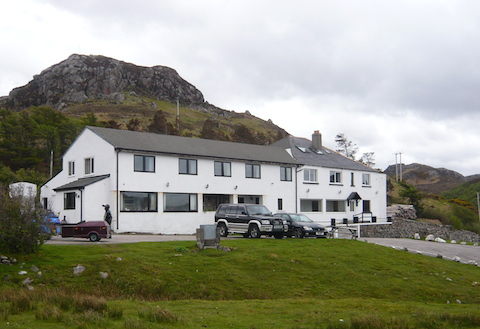

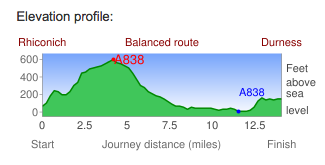
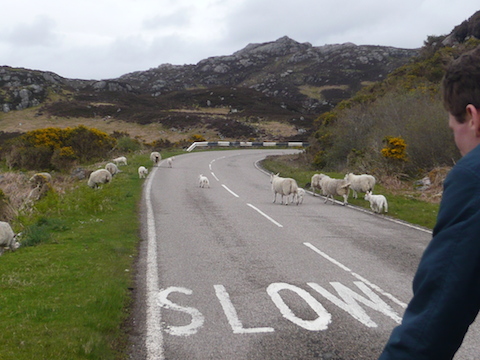
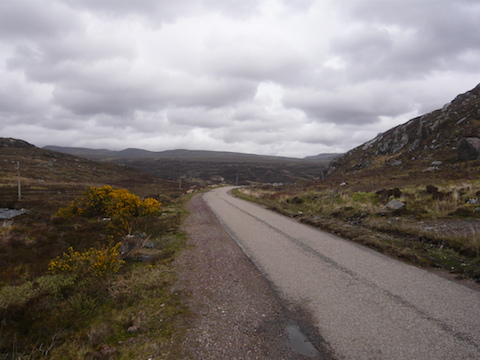
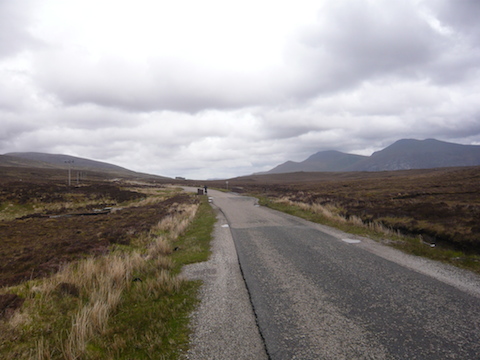

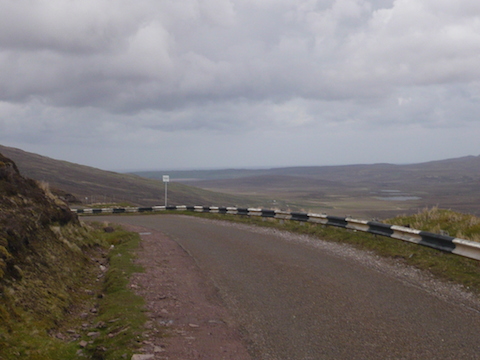
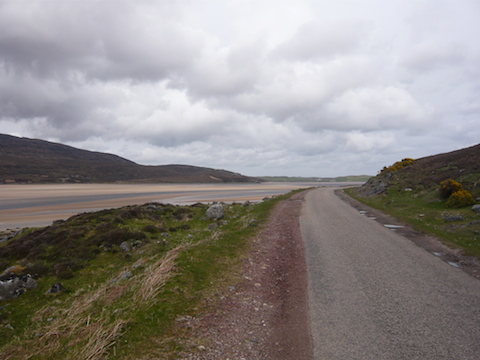
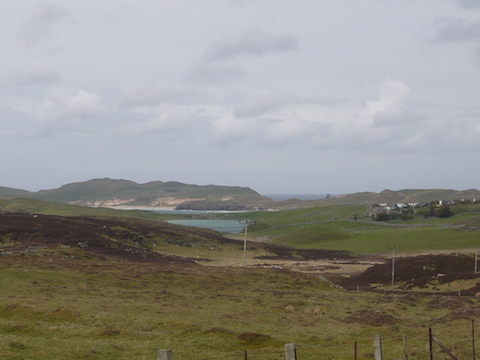













Doug and Bill Staniforth
May 30, 2015 at 9:08 am
OK Martin, can you wait where you are? We’ll be there next Thursday.